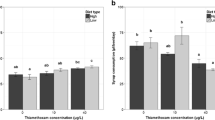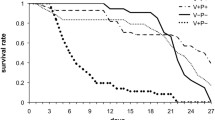Abstract
The transgenic Cry1Ac (Bt toxin) + CpTI (Cowpea Trypsin Inhibitor) cotton cultivar CCRI41 is increasingly used in China and potential side effects on the honey bee Apis mellifera L. have been documented recently. Two studies have assessed potential lethal and sublethal effects in young bees fed with CCRI41 cotton pollen but no effect was observed on learning capacities, although lower feeding activity in exposed honey bees was noted (antifeedant effect). The present study aimed at providing further insights into potential side effects of CCRI41 cotton on honey bees. Emerging honey bees were exposed to different pollen diets using no-choice feeding protocols (chronic exposure) in controlled laboratory conditions and we aimed at documenting potential mechanisms underneath the CCRI41 antifeedant effect previously reported. Activity of midgut proteolytic enzyme of young adult honey bees fed on CCRI41 cotton pollen were not significantly affected, i.e. previously observed antifeedant effect was not linked to disturbed activity of the proteolytic enzymes in bees’ midgut. Hypopharyngeal gland development was assessed by quantifying total extractable proteins from the glands. Results suggested that CCRI41 cotton pollen carries no risk to hypopharyngeal gland development of young adult honey bees. In the two bioassays, honey bees exposed to 1 % soybean trypsin inhibitor were used as positive controls for both midgut proteolytic enzymes and hypopharyngeal gland proteins quantification, and bees exposed to 48 ppb (part per billion) (i.e. 48 ng g−1) imidacloprid were used as controls for exposure to a sublethal concentration of toxic product. The results show that the previously reported antifeedant effect of CCRI41 cotton pollen on honey bees is not linked to effects on their midgut proteolytic enzymes or on the development of their hypopharyngeal glands. The results of the study are discussed in the framework of risk assessment of transgenic crops on honey bees.


Similar content being viewed by others
References
Abbott WS (1925) A method for computing the effectiveness of an insecticide. J Econ Entomol 18:265–267
Arno J, Gabarra R (2011) Side effects of selected insecticides on the Tuta absoluta (Lepidoptera: Gelechiidae) predators Macrolophus pygmaeus and Nesidiocoris tenuis (Hemiptera: Miridae). J Pest Sci 84:513–520
Babendreier D, Kalberer NM, Romeis J, Fluri P, Mulligan E, Bigler F (2005) Influence of Bt-transgenic pollen, Bt-toxin and protease inhibitor (SBTI) ingestion on development of the hypopharyngeal glands in honeybees. Apidologie 36:585–594
Babendreier D, Joller D, Romeis J, Bigler F, Widmer F (2007) Bacterial community structures in honeybee intestines and their response to two insecticidal proteins. FEMS Microbiol Ecol 59:600–610
Bakhsh A, Rao AQ, Shahid AA, Husnain T, Riazuddin S (2010) Camv 35S is a developmental promoter being temporal and spatial in expression pattern of insecticidal genes (Cry1ac & Cry2a) in cotton. Aust J Basic Appl Sci 4:37–44
Biondi A, Desneux N, Siscaro G, Zappalà L (2012) Using organiccertified rather than synthetic pesticides may not be safer for biological control agents: selectivity and side effects of 14 pesticides on the predator Orius laevigatus. Chemosphere 87:803–812
Bøhn T, Traavik T, Primicerio R (2010) Demographic responses of Daphnia magna fed transgenic Bt-maize. Ecotoxicology 19:419–430
Bradford MM (1976) A rapid and sensitive method for the quantitation of microgram quantities of protein utilizing the principle of protein-dye binding. Anal Biochem 72:248–254
Brittain C, Bommarco R, Vighi M, Barmaz S, Settele J, Potts SG (2010) The impact of an insecticide on insect flower visitation and pollination in an agricultural landscape. Agr For Entomol 12:259–266
Carrière Y, Ellers-Kirk C, Cattaneo MG, Yafuso CM, Antilla L, Huang CY, Rahman M, Orr BJ, Marsh SE (2009) Landscape effects of transgenic cotton on non-target ants and beetles. Basic Appl Ecol 10:597–606
Chen LZ, Cui JJ, Ma WH, Niu CY, Lei CL (2011) Pollen from Cry1Ac/CpTI-transgenic cotton does not affect the pollinating beetle Haptoncus luteolus. J Pest Sci 84:9–14
Clive J (2009) Global status of commercialized biotech/GM crops: 2009, The first fourteen years, 1996 to 2009. ISAAA brief no 41. ISAAA, Ithaca, NY
Cui JJ (2003) Effects and mechanisms of the transgenic Cry1Ac plus CpTI (cowpea trypsin inhibitor) cotton on insect communities. Dissertation, Chinese Academy of Agricultural Sciences
Dai PL, Zhou W, Zhang J, Cui HJ, Wang Q, Jiang WY, Sun JH, Wu YY, Zhou T (2012a) Field assessment of Bt cry1Ah corn pollen on the survival, development and behavior of Apis mellifera ligustica. Ecotoxicol Environ Safe 79:232–237
Dai PL, Zhou W, Zhang J, Jiang WY, Wang Q, Cui HJ, Sun JH, Wu YY, Zhou T (2012b) The effects of Bt Cry1Ah toxin on worker honeybees (Apis mellifera ligustica and Apis cerana cerana). Apidologie 43:384–391
Decourtye A, Mader E, Desneux N (2010) Landscape scale enhancement of floral resources for honey bees in agro-ecosystems. Apidologie 41:264–277
Decourtye A, Pham-Delègue MH (2002) The proboscis extension response: assessing the sublethal effects of pesticides on the honey bee. In: Devillers J, Pham-Delègue MH (eds) Honey Bees: Estimating the Environmental Impact of Chemicals. Taylor & Francis, London/New York, pp 67–81
Desneux N, Bernal JS (2010) Genetically modified crops deserve greater ecotoxicological scrutiny. Ecotoxicology 19:1642–1644
Desneux N, Decourtye A, Delpuech JM (2007) The sublethal effects of pesticides on beneficial arthropods. Annu Rev Entomol 52:81–106
Desneux N, Ramirez-Romero R, Bokonon-Ganta AH, Bernal JS (2010) Attraction of the parasitoid Cotesia marginiventris to host frass is affected by transgenic maize. Ecotoxicology 19:1183–1192
Fluri P, Lüscher M, Wille H, Gerig L (1982) Changes in weight of the pharyngeal gland and haemolymph titres of juvenile hormone, protein and vitellogenin in worker honeybees. J Insect Physiol 28:61–68
Gassmann AJ, Carriere Y, Tabashnik BE (2009) Fitness costs of insect resistance to Bacillus thuringiensis. Annu Rev Entomol 54:147–163
Giurfa M (2003) Cognitive neuroethology: dissecting non-elemental learning in a honeybee brain. Curr Opin Neurobiol 13:726–735
Han P, Niu CY, Lei CL, Cui JJ, Desneux N (2010a) Quantification of toxins in a Cry1Ac + CpTI cotton cultivar and its potential effects on the honey bee Apis mellifera L. Ecotoxicology 19:1452–1459
Han P, Niu CY, Lei CL, Cui JJ, Desneux N (2010b) Use of an innovative T-tube maze assay and the proboscis extension response assay to assess sublethal effects of GM products and pesticides on learning capacity of the honey bee Apis mellifera L. Ecotoxicology 19:1612–1619
Haydak MH (1970) Honey bee nutrition. Annu Rev Entomol 15:143–156
He YX, Zhao J, Zheng Y, Zhan Z, Desneux N, Wu KM (2012) Lethal effect of imidacloprid on the coccinellid predator Serangium japonicum and sublethal effects on predator voracity and on functional response to the whitefly Bemisia tabaci. Ecotoxicology 21:1291–1300
Hendriksma HP, Härtel S, Steffan-Dewenter I (2011) Testing pollen of single and stacked insect-resistant Bt-maize on in vitro reared honey bee larvae. PLoS One 6:e28174. doi:10.1371/journal.pone.0028174
Hrassnigg N, Crailsheim K (1998) Adaptation of hypopharyngeal gland development to the brood status of honeybee (Apis mellifera L.) colonies. J Insect Physiol 44:929–939
Hyams DG (1993) CurveExpert Software Version 1.38: A curve fitting system for windows, Mississippi
Knecht D, Kaatz HH (1990) Patterns of larval food production by hypopharyngeal glands in adult worker honey bees. Apidologie 21:457–468
Laskowski M, Kato L (1980) Protein inhibitors of proteinases. Annu Rev Biochem 49:593–626
Li GP, Feng HQ, McNeil JN, Liu B, Chen PY, Qiu F (2011) Impacts of transgenic Bt cotton on a non-target pest, Apolygus lucorum (Meyer-Dür) (Hemiptera: miridae), in northern China. Crop Prot 30:1573–1578
Liu B, Shu C, Xue K, Zhou KX, Li XG, Liu DD, Zheng YP, Xu CR (2009) The oral toxicity of the transgenic Bt + CpTI cotton pollen to honey bees (Apis mellifera). Ecotox Environ Safe 72:1163–1169
Lu YH, Wu KM, Jiang YY, Guo YY, Desneux N (2012) Widespread adoption of Bt cotton and insecticide decrease promotes biocontrol services. Nature 487:362–365
Malone LA, Pham-Delègue MH (2001) Effects of transgene products on honey bees (Apis mellifera) and bumblebees (Bombus sp.). Apidologie 32:287–304
Malone LA, Todd JH, Burgess EPJ, Christeller JT (2004) Development of hypopharyngeal glands in adult honey bees fed with a Bt toxin, a biotin-binding protein and a protease inhibitor. Apidologie 35:655–664
Michener CD (1974) The social behavior of the bees: a comparative study. Harvard University Press, Cambridge
Moritz B, Crailsheim K (1987) Physiology of protein digestion in the midgut of the honeybee (Apis mellifera L.). J Insect Physiol 33:923–931
Patel NG, Haydak MH, Gochnauer TA (1960) Electrophoretic components of the proteins in honeybee larval food. Nature 186:633–634
Ramirez-Romero R, Josette C, Pham-Delègue MH (2005) Effects of Cry1Ab protoxin, deltamethrin and imidacloprid on the foraging activity and the learning performances of the honeybee Apis mellifera, a comparative approach. Apidologie 36:601–611
Ramirez-Romero R, Desneux N, Chaufaux J, Kaiser L (2008a) Bt-maize effects on biological parameters of the non-target aphid Sitobion avenae (Homoptera: Aphididae) and Cry1Ab toxin detection. Pestic Biochem Physiol 91:110–115
Ramirez-Romero R, Desneux N, Decourtye A, Chaffiol A, Pham-Delègue MH (2008b) Does Cry1Ab protein affect learning performance of the honey bee Apis mellifera L. (Hymenoptera, Apidae)? Ecotoxicol Environ Safe 70:327–333
Robinson GE (1992) Regulation of division of labor in insect societies. Annu Rev Entomol 37:637–665
Romeis J, Bartsch D, Bigler F et al (2008) Assessment of risk of insect-resistant transgenic crops to non-target arthropods. Nat Biotechnol 26:203–208
Rui YK, Wang BM, Li ZH, Duan LS, Tian XL, Zhai ZX, He ZP (2004) Development of an enzyme immunoassay for the determination of the cowpea trypsin inhibitor (CpTI) in transgenic crop. Sci Agric Sin 37:1575–1579
Sagili RR, Pankiw T (2007) Effects of protein-constrained brood food on honey bee (Apis mellifera L.) pollen foraging and colony growth. Behav Ecol Sociobiol 61:1471–1478
Sagili RR, Pankiw T, Zhu-Salzman K (2005) Effects of soybean trypsin inhibitor on hypopharyngeal gland protein content, total midgut protease activity and survival of the honey bee (Apis mellifera L.). J Insect Physiol 51:953–995
SAS Institute (1999) SAS/Stat user’s guide, release 8 edn. SAS Institute, Cary, NC
Siebert MW, Patterson TG, Gilles GJ, Nolting SP, Braxton LB, Leonard BR, Van Duyn JW, Lassiter RB (2009) Quantification of Cry1Ac and Cry1F Bacillus thuringiensis insecticidal proteins in selected transgenic cotton plant tissue types. J Econ Entomol 102:1301–1308
Srinivasan MV (2010) Honey bees as a model for vision, perception, and cognition. Annu Rev Entomol 55:267–284
Stara J, Ourednickova J, Kocourek F (2011) Laboratory evaluation of the side effects of insecticides on Aphidius colemani (Hymenoptera: Aphidiidae), Aphidoletes aphidimyza (Diptera: Cecidomyiidae), and Neoseiulus cucumeris (Acari: Phytoseidae). J Pest Sci 84:25–31
Wratten SD, Gillespie M, Decourtye A, Mader E, Desneux N (2012) Pollinator habitat enhancement: benefits to other ecosystem services. Agr Ecosyst Environ doi:10.1016/j.agee.2012.06.020
Wu KM, Lu YH, Feng HQ, Jiang YY, Zhao JZ (2008) Suppression of cotton bollworm in multiple crops in China in areas with Bt toxin-containing cotton. Science 321:1676–1678
Yu HL, Li YH, Wu KM (2011) Risk assessment and ecological effects of transgenic Bacillus thuringiensis crops on non-target organisms. J Integr Plant Biol 53:520–538
Acknowledgments
We are grateful to Xiaoxia Dong, Shifeng Yu and Haixia Yang for technical help for the dissection works on honey bees during the study, and to JB Yang for technical assistance for honey bee rearing. This work was supported by the National Natural Science Foundation of China (Grant No. 31071690). The authors declare that they have no conflict of interest.
Author information
Authors and Affiliations
Corresponding author
Electronic supplementary material
Below is the link to the electronic supplementary material.
Rights and permissions
About this article
Cite this article
Han, P., Niu, CY., Biondi, A. et al. Does transgenic Cry1Ac + CpTI cotton pollen affect hypopharyngeal gland development and midgut proteolytic enzyme activity in the honey bee Apis mellifera L. (Hymenoptera, Apidae)?. Ecotoxicology 21, 2214–2221 (2012). https://doi.org/10.1007/s10646-012-0976-2
Accepted:
Published:
Issue Date:
DOI: https://doi.org/10.1007/s10646-012-0976-2




